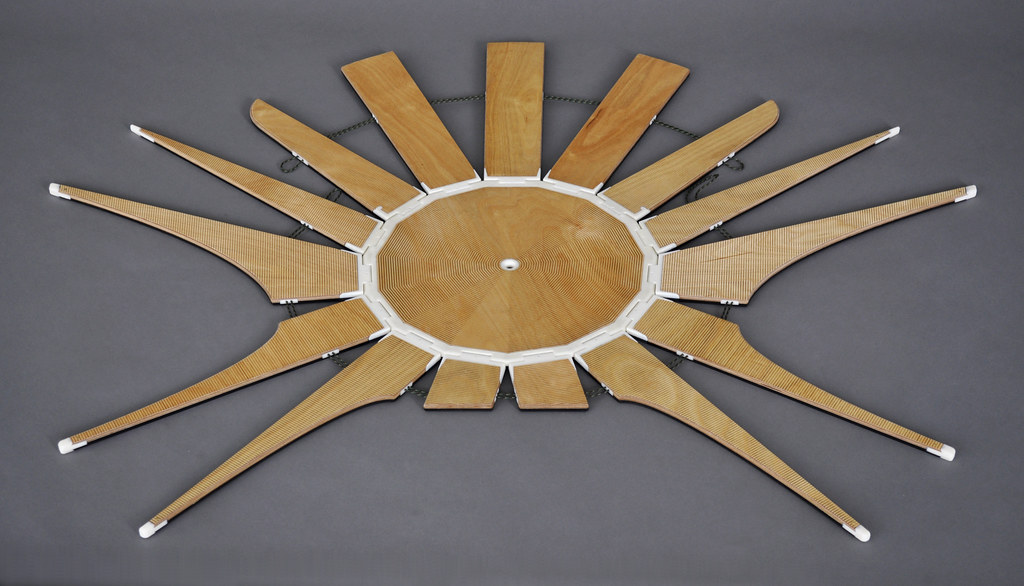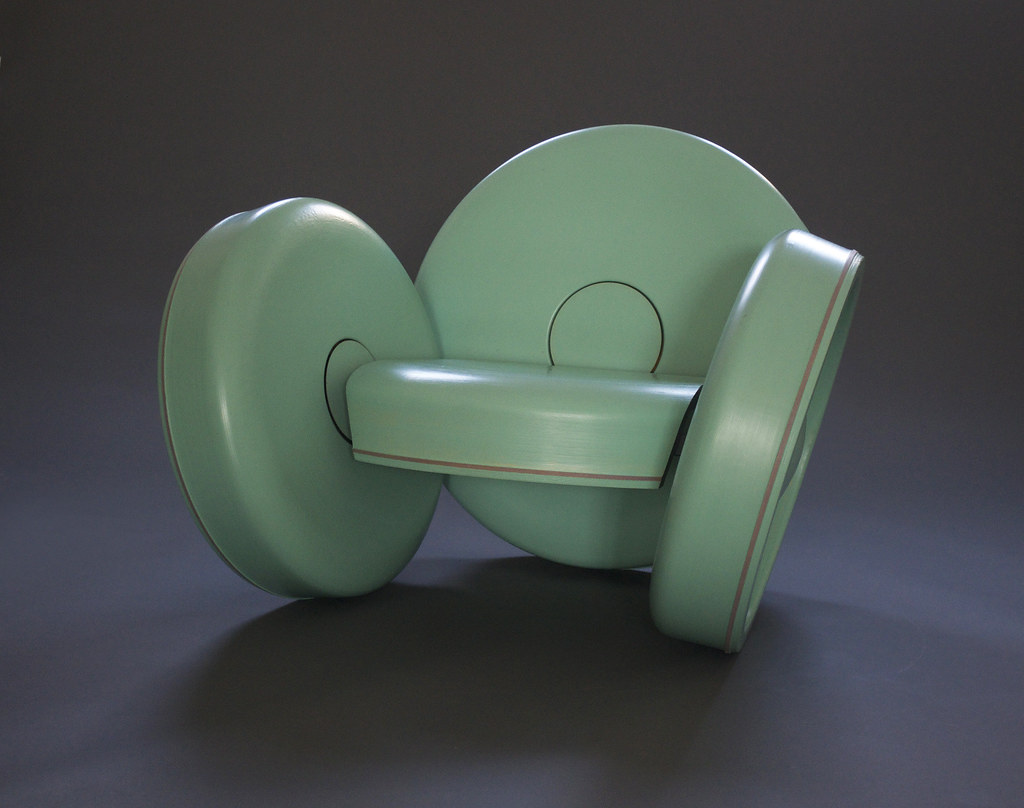there is in its place a gentle side-to-side rising and falling motion. "
"Whirl, by Ian Stell"
WHIRL. The perfect chair circle.
Ian Stell: Whirl has had a slow gestation. It was born out of a life-long curiosity about the basic shapes employed within simple machines and tools. A wheel is arguably the most succinct emblem of harnessed energy. Whirl is composed of two pairs of bowl-like wheel forms. Two smaller ones act as armrests; a larger one is employed as a backrest, and its twin is cropped as a seating surface. The backrest is, of course, what is novel about this ensemble. Where the occupant expects a certain stasis there is in its place a gentle side-to-side rising and falling motion. As the outlying members are linked to the center with high performance go-kart bearings, a slight push will cause the empty chair to spin for a surprisingly long time.
The matters concerning your recent works?
My RISD thesis topic ties my current work with an early chapter in my life. From the ages of eight to thirteen, I sang with the children’s choruses of the New York City, and Metropolitan Opera Companies. My memory of singing in a large group–feeling like a thread entwined within sonic fabric–is a rich one. I’m exploring parallels between choral score and performance and the often complex, dynamic structures present in my designs.

RISD. Can you talk about the program, pros and cons? Any advice for someone beginning to make objects?
RISD is an extraordinary place. To give a sense of the culture, this morning I had in-depth conversations about my work with a senior research engineer from Brown (there’s a great deal of reciprocity between the art school and the university) and an art history professor/performance artist from Venice. The Furniture Design program is a jewel. About ten years ago, it broke off from the Industrial Design department, and what distinguishes it from its parent is that its founders believe that great design is the fruit of both intelligent eyes and hands. In other words they believe as I do that it’s imperative for design students to learn how to build. This isn’t merely because it makes for higher quality products. Each time an experienced designer gains knowledge of a fabrication technique–whether it be from the bronze age or the twenty-first century–it’s like adding another color to their pallet. It shapes thoughts and decisions at the naissance of every new idea.



The Femten Chair. Why would someone want to turn a chair inside out?
Ian: The objects I make tend to have complex, and often open-ended programs. I imagine it would be nice if it took a moment for them to find their job and home. I’ve designed and built several different forms that have pivoting members encircling a central plane. This radial folding pattern allows them to assume a number of shapes. Femten spends a fair amount of its time splayed flat on a wall. In this configuration, it almost becomes a drawing, or a diagram of its functional structure. Folding chair typology is for the most part binary: Store, deploy, store again. Other things can be accomplished by incorporating hinges into seating. This design has the ability to act as a backed chair or a stool/table, for multiples to nest in either of these configurations, to ship flat at half an inch thick, and–like a flower–to turn itself inside out.
Designing and building bars and restaurants? What was your favorite part of the process?
I studied painting and sculpture at the Art Institute of Chicago, and after graduated I moved back to Manhattan, where I was raised. Soon after, A sculptor friend, Michael Drury, and I had the somewhat naive notion that we could support our art-making endeavors by opening a bar on the lower east side. This first venture, Orchard, had a brief, but rich heyday. It was a tiny place, nestled amid roll gates on a street that was otherwise deserted at night. We hosted parties with the full spectrum of New York culture–from George Plimpton to Moby. The attention we received for this first venue inspired us to open two more bars (Double Happiness and Palais Royale), and a restaurant (Wyanoka). We designed and built these spaces ourselves (from floor to ceiling, including all of the plumbing and electrical work) without any formal training in, or exposure to the design or building trades. Looking back, it was as if we were making narrative artworks about bars and restaurants, rather than fulfilling the brief of an entrepreneurial business plan. The physical results were generally charming and quirky. Sometimes our solutions were extraordinarily impractical and at other times they were incredibly effective in unusual ways. But it was out of this experience that I developed a fascination with making objects that can be touched and manipulated as well as experienced visually.
THE LAST WEE SEE EYE TO EYE. your objects have a poetry that I connect more with artists, than designers
I think there are many of us these days that define ourselves as either designers or artists more because of external circumstances than by what we think, feel or create. These could be who our friends are at a given moment or even our financial circumstances, among myriad other factors. Forty years after Warhol’s moment, and almost a century after Duchamp’s, it’s striking that such delineations are still so pronounced. But at the same time I think there might be some kind of vitality gained through pushback. I think of the brilliant, if intractable, Richard Artschwager. I’m drawn to anamorphosis because it’s multiple irreconcilable things at the same time. It can be an evocative abstract form, while at the same time precise encoded information. It can be text, texture and textile. When I discovered that anamorphic text could be layered at perpendicular angles (Newdrift Bench) and still, improbably, be legible in both directions, a broad range of possibilities opened. I feel like I’m just starting to explore this. Somehow I picture The Last We See Eye To Eye as part of something larger – maybe as an excerpt of a mile long novel/fence, or perhaps it’s a scale model of a skyscraper façade.
for more info, go to Ian Stell's site.
-----------
You have read this article conversation with Ian Stell /
ian stell /
product design /
RISD
with the title A conversation with Ian Stell. You can bookmark this page URL http://gigibytes.blogspot.com/2012/04/a-conversation-with-ian-stell.html. Thanks!







No comment for "A conversation with Ian Stell"
Post a Comment